Lincoln Navigator: Rear End Sheet Metal Repairs / Rear Wheelhouse. Removal and Installation
Special Tool(s) /
General Equipment
| 6.5 mm Drill Bit |
| Spherical Cutter |
| Self-Piercing Rivet (SPR) Remover/Installer |
| Belt Sander |
| Blind Rivet Gun |
| Air Body Saw |
| MIG/MAG Welding Equipment |
| Locking Pliers |
Materials
| Name |
Specification |
Metal Bonding Adhesive
TA-1, TA-1-B, 3M™ 08115, LORD Fusor® 108B, Henkel Teroson EP 5055 |
-
|
Seam Sealer
TA-2-B, 3M™ 08308, LORD Fusor® 803DTM |
-
|
Flexible Foam Repair
3M™ 08463, LORD Fusor® 121 |
-
|
Removal
NOTICE:
Bodyside sectioning is prohibited within 50 mm of door hinge, door striker and restraints anchoring points.
NOTE:
The wheelhouse outer panel may be sectioned for repair using
a backer plate, adhesive and blind rivets. The following steps assume
full component replacement. Adjust to meet repair needs.
NOTE:
SPR fasteners may not be placed directly over original SPR location.
They must be placed adjacent to original location matching original
quantity.
NOTE:
LH side shown, RH side similar.
NOTE:
Aluminum body panels are highly receptive to heat transfer.
With the extensive use of structural adhesives and non-structural
sealers used in vehicle construction, the potential of heat transfer
could impact adhesives and sealers in non-associated panels during the
repair process. Many repairs areas that utilize structural adhesive may
be separated after fastener removal by using a panel chisel along the
joint/flange. Using heat not exceeding 425° F to loosen a bonded panel
should only be done when all panels in the joint will be replaced and
new adhesive applied.
NOTE:
LH side shown, RH side shown.
-
Remove the liftgate.
Refer to: Liftgate (501-03 Body Closures, Removal and Installation).
-
Remove the C-pillar trim panel.
Refer to: C-Pillar Trim Panel (501-05 Interior Trim and Ornamentation, Removal and Installation).
-
Remove the loadspace interior trim.
Refer to: Loadspace Trim Panel (501-05 Interior Trim and Ornamentation, Removal and Installation).
-
Remove the wheel and tire on the affected side.
Refer to: Wheel and Tire (204-04A Wheels and Tires, Removal and Installation).
-
Remove the quarter panel.
Refer to: Quarter Panel (501-30 Rear End Sheet Metal Repairs, Removal and Installation).
-
Remove the wheel opening splash shield.
-
Remove the rear door striker.
-
Cut section of the rear dear opening panel outer layer only as indicated.
Use the General Equipment: Air Body Saw
Use the General Equipment: Spherical Cutter
-
Remove the rivet fasteners from the rear door opening panel.
Use the General Equipment: Self-Piercing Rivet (SPR) Remover/Installer
Use the General Equipment: Belt Sander
-
Break the adhesive bond, remove the wheel opening flange material and remove the door opening panel section.
Use the General Equipment: Spherical Cutter
-
Position aside the roof opening panel water drain tube, if equipped.
-
Remove the C-pillar lower reinforcement fasteners.
Use the General Equipment: Self-Piercing Rivet (SPR) Remover/Installer
Use the General Equipment: Belt Sander
-
NOTE:
Long wheelbase (LWB) shown, short wheelbase (SWB) similar.
Note NVH foam locations when removing panel.
Break the adhesive bond and remove the C-pillar lower reinforcement.
-
Remove the fasteners.
Use the General Equipment: Self-Piercing Rivet (SPR) Remover/Installer
Use the General Equipment: Belt Sander
-
Remove the upper flange fasteners.
Use the General Equipment: Self-Piercing Rivet (SPR) Remover/Installer
Use the General Equipment: Belt Sander
-
Remove the fasteners.
Use the General Equipment: Self-Piercing Rivet (SPR) Remover/Installer
Use the General Equipment: Belt Sander
-
Break the adhesive and sealer bond and remove the outer wheelhouse panel.
Installation
NOTE:
Aluminum body panels are highly receptive to heat transfer.
With the extensive use of structural adhesives and non-structural
sealers used in vehicle construction, the potential of heat transfer
could impact adhesives and sealers in non-associated panels during the
repair process. Many repairs areas that utilize structural adhesive may
be separated after fastener removal by using a panel chisel along the
joint/flange. Using heat not exceeding 425° F to loosen a bonded panel
should only be done when all panels in the joint will be replaced and
new adhesive applied.
NOTE:
SPR fasteners may not be placed directly over original SPR location.
They must be placed adjacent to original location matching original
quantity.
NOTE:
Blind or solid rivet fasteners may be used in place of SPR fasteners after enlarging holes to 6.5 mm.
-
Sand to remove e-coating using 80-120 grit sandpaper on the replacement panel.
-
Sand inner wheelhouse mating surface using 80-120 grit sandpaper.
-
Apply adhesive and NVH foam as indicated.
Material: Metal Bonding Adhesive
/ TA-1, TA-1-B, 3M™ 08115, LORD Fusor® 108B, Henkel Teroson EP 5055
Material: Flexible Foam Repair
/ 3M™ 08463, LORD Fusor® 121
-
Install and clamp the wheelhouse panel in position.
Refer to: Joining Techniques (501-25 Body Repairs - General Information, General Procedures).
Use the General Equipment: Locking Pliers
-
Drill for rivets.
Use the General Equipment: 6.5 mm Drill Bit
-
Install blind rivet fasteners.
|
Item
|
SPR Number
|
SPR Code
|
Henrob® Mandrel
|
Pro-Spot® Mandrel
|
Blind Rivet
|
Solid Rivet
|
Rivnut®
|
|
1
|
-
|
-
|
-
|
-
|
W708777-S900C
|
-
|
-
|
Use the General Equipment: Blind Rivet Gun
-
Install rivet fasteners.
|
Item
|
SPR Number
|
SPR Code
|
Henrob® Mandrel
|
Pro-Spot® Mandrel
|
Blind Rivet
|
Solid Rivet
|
Rivnut®
|
|
1
|
-
|
-
|
-
|
-
|
W702554-S900C
|
-
|
-
|
-
Drill for MIG plug welds.
Use the General Equipment: 6.5 mm Drill Bit
-
Install MIG plug welds.
Use the General Equipment: MIG/MAG Welding Equipment
-
Sand and clean the mating surface using 80-120 grit sandpaper.
-
Sand and clean the mating surface using 80-120 grit sandpaper.
-
Apply adhesive and NVH foam as indicated.
Material: Metal Bonding Adhesive
/ TA-1, TA-1-B, 3M™ 08115, LORD Fusor® 108B, Henkel Teroson EP 5055
Material: Flexible Foam Repair
/ 3M™ 08463, LORD Fusor® 121
-
Install and clamp the C-pillar lower reinforcement panel.
Use the General Equipment: Locking Pliers
-
Drill for blind rivet fasteners.
Use the General Equipment: 6.5 mm Drill Bit
-
NOTE:
SPR fasteners may be replaced with solid rivets or blind rivet fasteners after enlarging hole to 6.5 mm.
NOTE:
SPR
fasteners may not be placed directly over original location. They must
equal original quantity and be placed adjacent to original location.
Install rivet fasteners.
|
Item
|
SPR Number
|
SPR Code
|
Henrob® Mandrel
|
Pro-Spot® Mandrel
|
Blind Rivet
|
Solid Rivet
|
Rivnut®
|
|
1
|
W712218-S900
|
DB
|
DZ09-025/H
|
SA-0400/SA-0401
|
W702512-S900C
|
W790376-S900
|
-
|
|
2
|
-
|
-
|
-
|
-
|
W702512-S900C
|
-
|
-
|
|
3
|
-
|
-
|
-
|
-
|
W702512-S900C
|
-
|
-
|
|
4
|
-
|
-
|
|
-
|
W707638-S900C
|
-
|
-
|
|
5
|
-
|
-
|
-
|
-
|
W08777-S900C
|
-
|
-
|
Use the General Equipment: Self-Piercing Rivet (SPR) Remover/Installer
-
Cut section from the service panel to fit repair.
Use the General Equipment: Spherical Cutter
Use the General Equipment: Air Body Saw
-
Sand to remove e-coating on flanges of replacement section.
-
Sand to remove old adhesive on mating surfaces.
-
Apply adhesive and NVH foam to mating surfaces as indicated.
Material: Metal Bonding Adhesive
/ TA-1, TA-1-B, 3M™ 08115, LORD Fusor® 108B, Henkel Teroson EP 5055
Material: Flexible Foam Repair
/ 3M™ 08463, LORD Fusor® 121
-
NOTE:
The use of a backer plate when creating butt weld joints will produce a stronger and more uniform repair.
In butt-weld areas: Create a backer plate
from an unused portion of the old body panel or service replacement
panel and install on the vehicle at each sectioning joint.
Refer to: Joining Techniques (501-25 Body Repairs - General Information, General Procedures).
-
Install and clamp the door opening panel section in position.
Use the General Equipment: Locking Pliers
-
NOTE:
SPR fasteners may be replaced with solid rivets or blind rivet fasteners after enlarging hole to 6.5 mm.
NOTE:
SPR
fasteners may not be placed directly over original location. They must
equal original quantity and be placed adjacent to original location.
Install fasteners.
|
Item
|
SPR Number
|
SPR Code
|
Henrob® Mandrel
|
Pro-Spot® Mandrel
|
Blind Rivet
|
Solid Rivet
|
Rivnut®
|
|
1
|
W708713-S900
|
AS
|
DZ09-025/H
|
SA-0400/SA-0401
|
-
|
W790376-S900
|
-
|
|
2
|
W717184-S900
|
QA
|
DP10-200/H
|
SA-0400/SA-0402
|
-
|
W790377-S900
|
-
|
|
3
|
W717186-S900
|
EN
|
DP11-200/H
|
SA-0400/SA-0402
|
-
|
W790377-S900
|
-
|
-
Seam weld the sectioning joints.
Use the General Equipment: MIG/MAG Welding Equipment
-
Metal finish the repair using typical aluminum metal finishing techniques and a fiber-based body filler.
Refer to: Special Repair Considerations for Aluminum Repairs (501-25
Body Repairs - General Information, Description and Operation).
-
Seam Sealing:
All areas must be sealed to production level.
Material: Seam Sealer
/ TA-2-B, 3M™ 08308, LORD Fusor® 803DTM
-
Refinish the repair area using a Ford approved paint system and typical refinishing techniques.
-
Install the quarter panel.
Refer to: Quarter Panel (501-30 Rear End Sheet Metal Repairs, Removal and Installation).
-
Install the wheel opening splash shield.
-
Install the C-pillar trim panel.
Refer to: C-Pillar Trim Panel (501-05 Interior Trim and Ornamentation, Removal and Installation).
-
Install the loadspace interior trim.
Refer to: Loadspace Trim Panel (501-05 Interior Trim and Ornamentation, Removal and Installation).
-
Install the wheel and tire on the affected side.
Refer to: Wheel and Tire (204-04A Wheels and Tires, Removal and Installation).
-
Install the rear door striker.
Torque:
Striker :
18 lb.ft (25 Nm)
-
Install the rear door scuff plate and door opening weather strip.
-
Install the liftgate and align as necessary.
Refer to: Liftgate (501-03 Body Closures, Removal and Installation).
Refer to: Liftgate Alignment (501-03 Body Closures, General Procedures).
Special Tool(s) /
General Equipment
6.5 mm Drill Bit
Self-Piercing Rivet (SPR) Remover/Installer
Belt Sander
Blind Rivet Gun
Locking Pliers
Materials
Name
Specification
Metal Bonding AdhesiveTA-1, TA-1-B, 3M™ 08115, LORD Fusor® 108B, Henkel Teroson EP 5055
-
Seam SealerTA-2-B, 3M™ 08308, LORD Fusor® 803DTM
-..
Other information:
Special Tool(s) /
General Equipment
6.5 mm Drill Bit
Polydrive Bit Socket
Self-Piercing Rivet (SPR) Remover/Installer
Belt Sander
Blind Rivet Gun
Hot Air Gun
Locking Pliers
Materials
Name
Specification
Metal Bonding AdhesiveTA-1, TA-1-B, 3M™ 08115, LORD Fusor® 108B, Henkel Teroson EP 5055
-
Remo..
Removal
NOTE:
Removal steps in this procedure may contain installation details.
Detach the clips and remove the lower steering column opening cover.
Detach the clips and remove the instrument panel lower side trim panel.
Detach the clips and remove the instrument panel upper s..
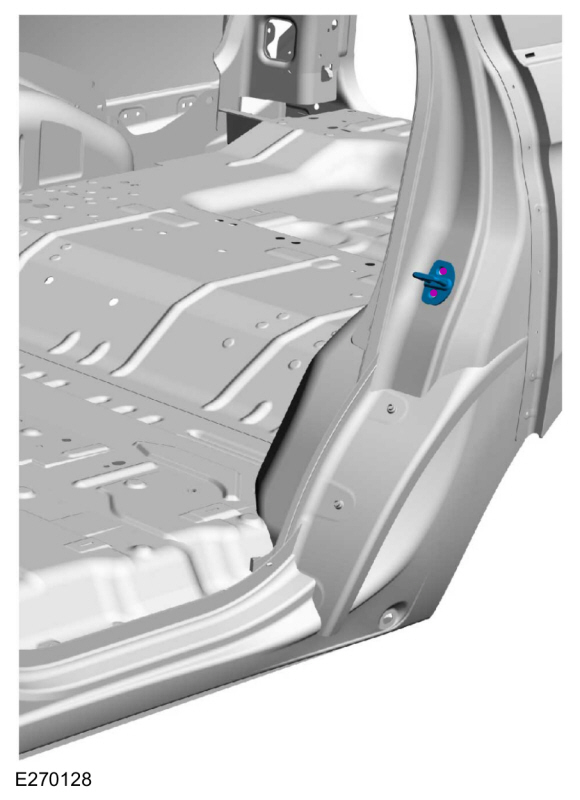
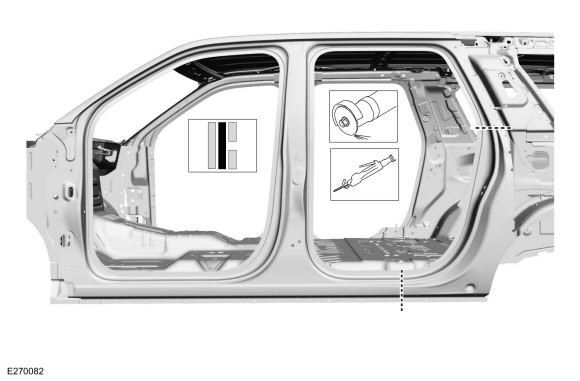
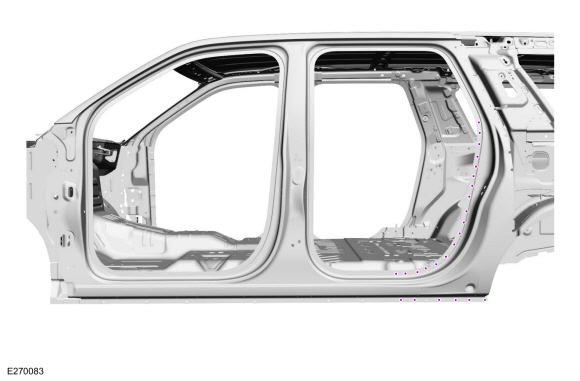
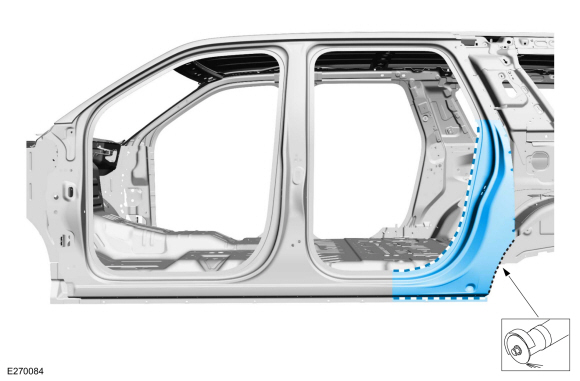
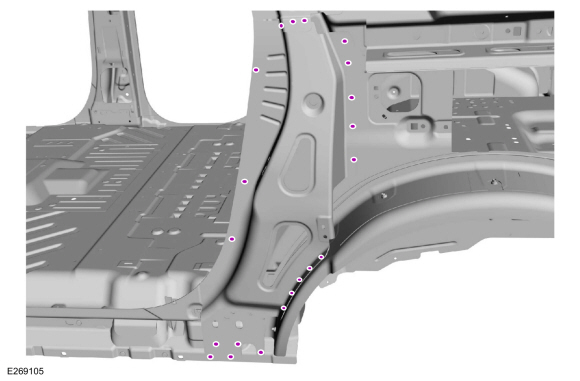
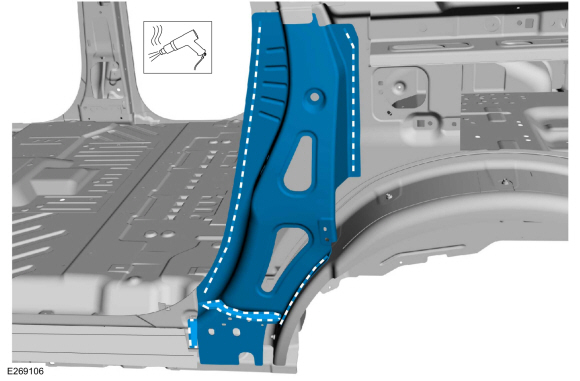
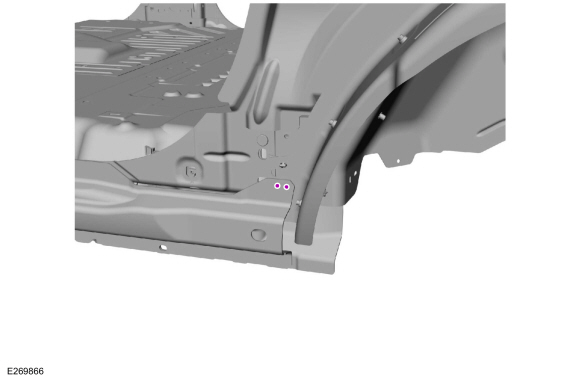
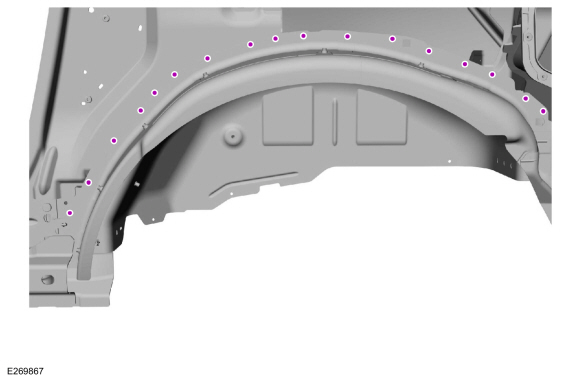
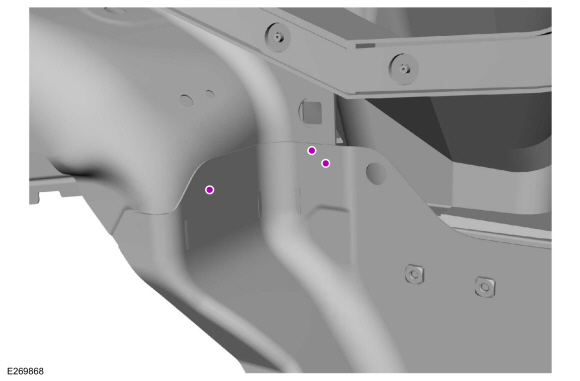
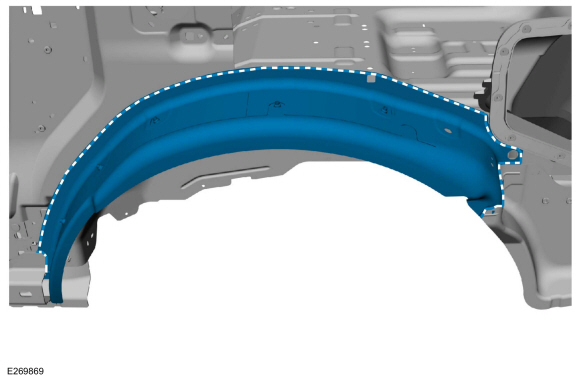
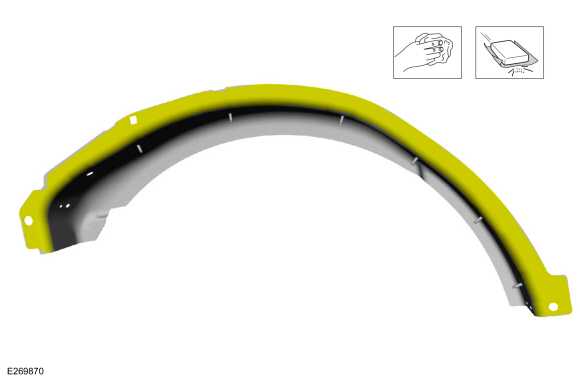
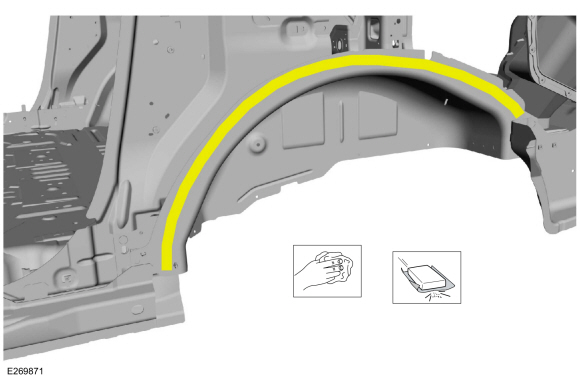
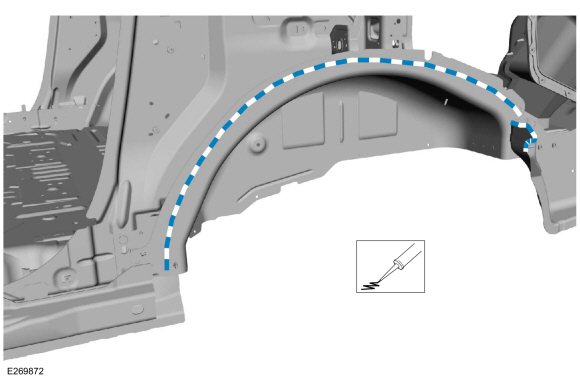
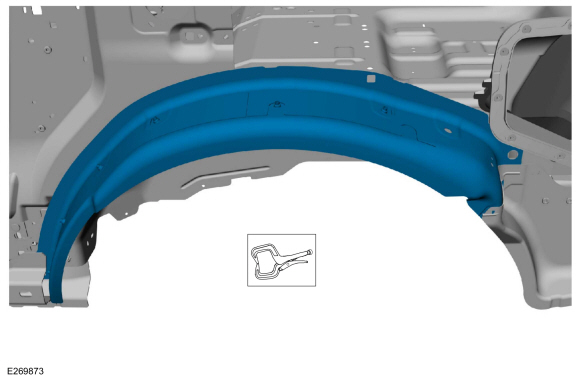
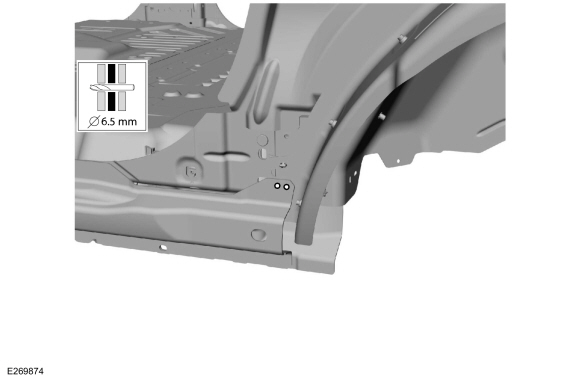
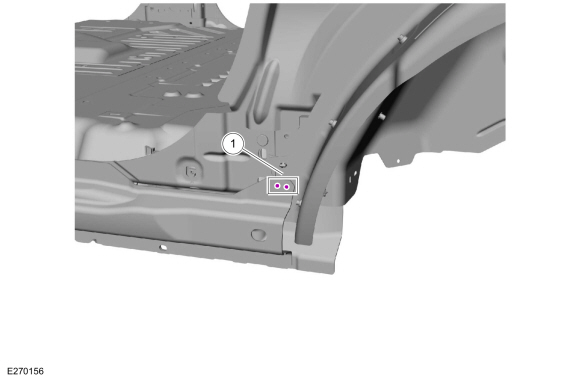
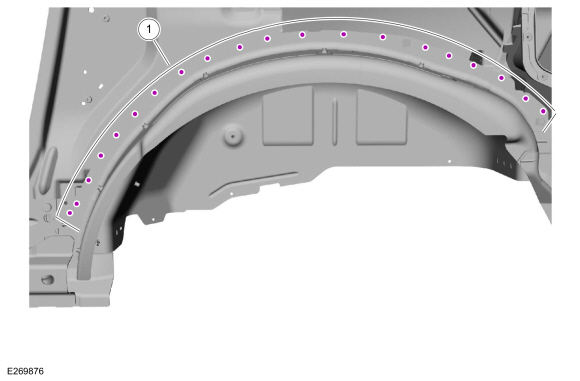
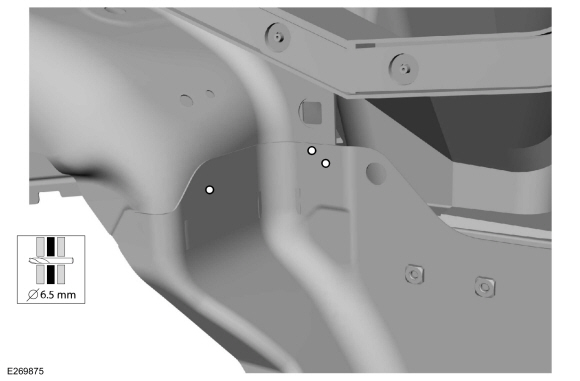
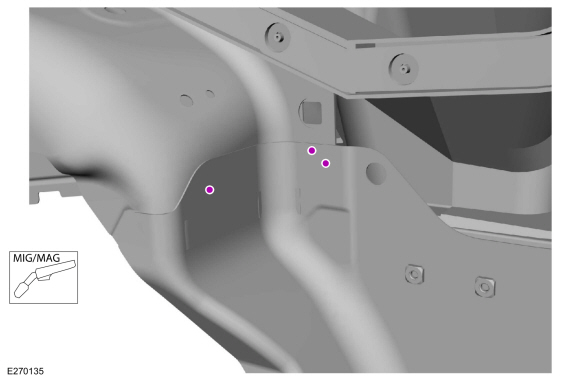
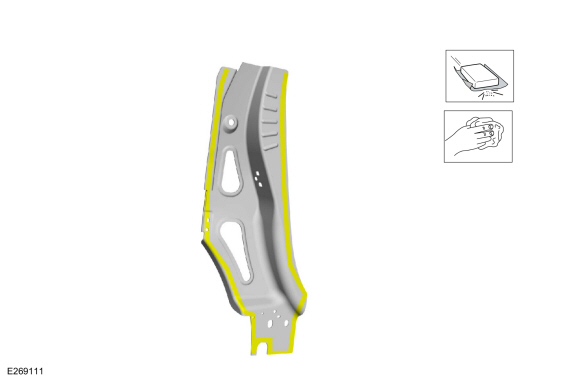


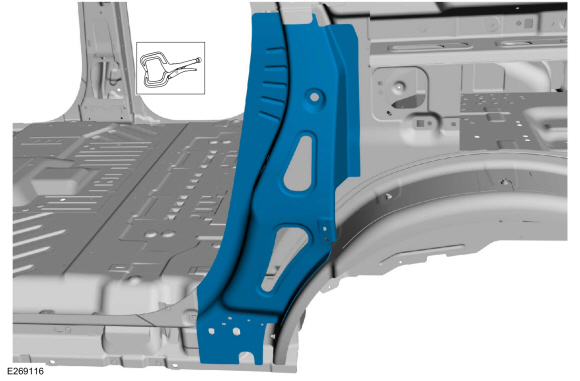
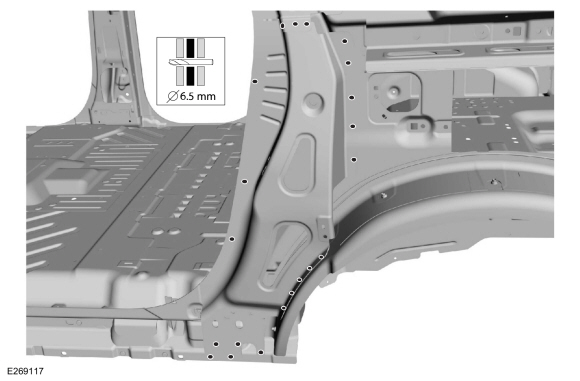
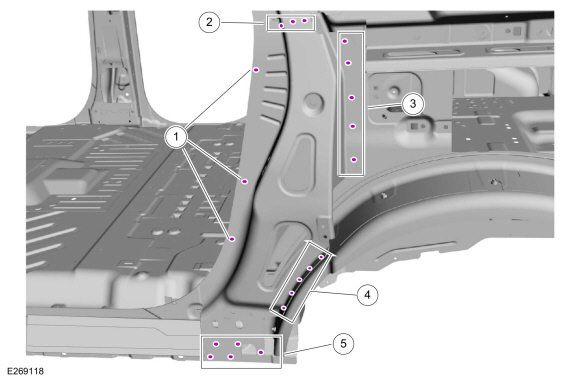
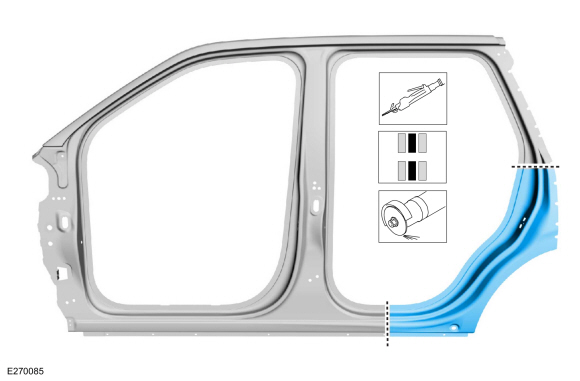
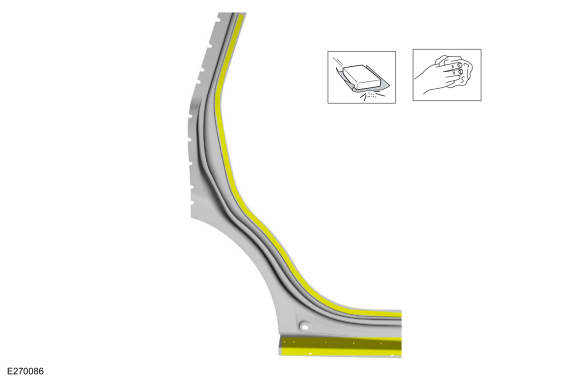
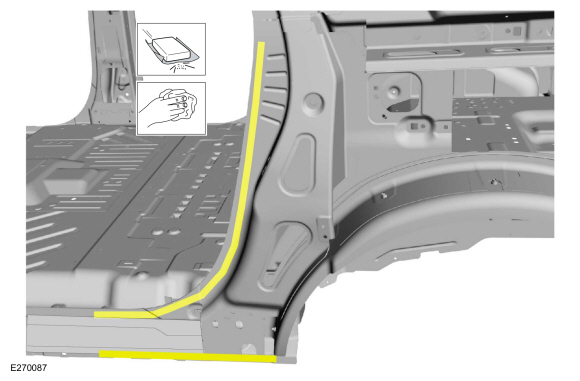
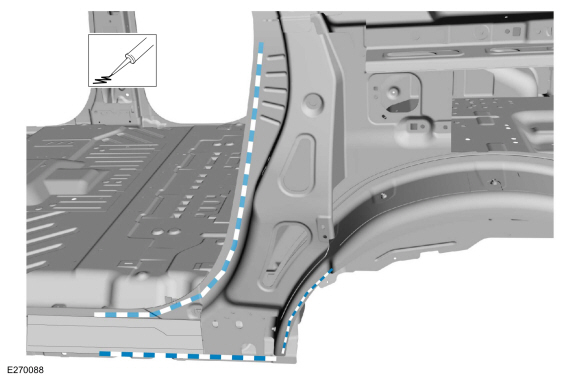
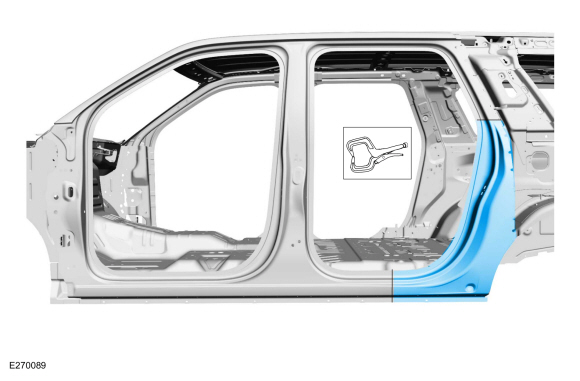
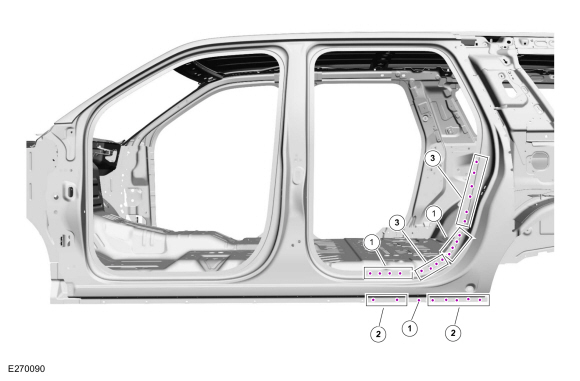
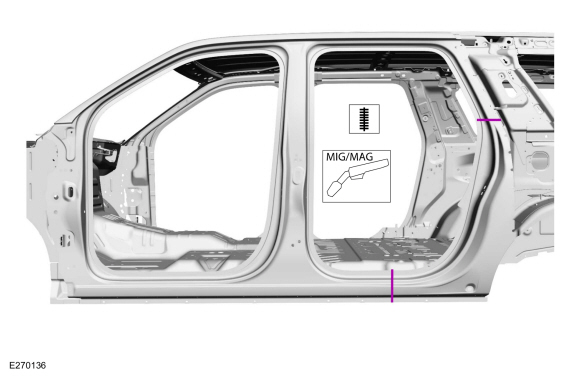

 Water Drain Panel. Removal and Installation
Water Drain Panel. Removal and Installation
